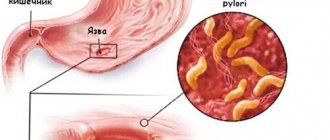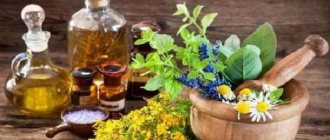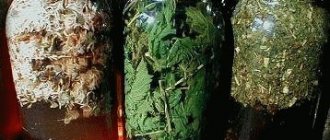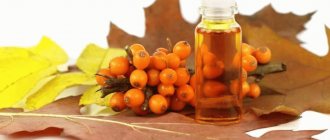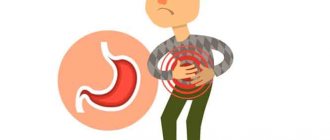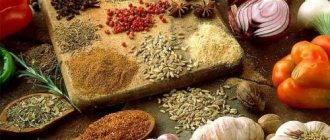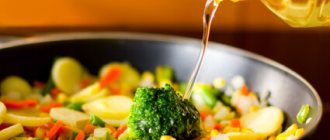Pain in the stomach area can be caused by a variety of reasons. The main factors that provoke malaise are gastritis, ulcers or consumption of low-quality foods. Folk remedies for stomach pain can effectively cope with cramps.
However, before using them, it is very important to visit a doctor and undergo a diagnosis to find out the exact cause of pain. My stomach hurts. What is the reason?
- Factors that contribute to the occurrence of cramps in the stomach are most often:
- Foods that may be stale or simply not suitable for a person.
- Binge eating.
- Presence of temperature and heaviness in the stomach. Symptoms in combination with nausea and vomiting indicate the development of an inflammatory process in the abdominal cavity or poisoning. To determine the cause, you will need to undergo an ultrasound.
- Development of pancreatitis or damage to the cardiovascular system. As a rule, the pain in this case is dull in nature.
Types of stomach diseases and their signs
The gastrointestinal tract system consists of different organs that take part in the processes of swallowing, digesting, and assimilating food. After chewing food, it enters the pharynx, then the esophagus, stomach, intestines, and colon. And also in the digestion of food, working organs such as the pancreas, gallbladder, liver, kidneys, and adrenal glands are involved. Problems in the functioning of one or more of these organs can lead to the development of serious pathologies and diseases.
According to statistics, men are more susceptible to gastrointestinal diseases. This is due to bad habits, especially alcohol abuse, the habit of going to the doctor too late, when the stomach does not work at all.
Common gastroenterological diseases include:
- Ulcer of the stomach and duodenum. Involves injury to the mucous membrane, severe inflammation caused by an increase in the amount of acid and bile. Abdominal pain with a peptic ulcer can be felt in different places, but more often they are in the center of the abdomen - around the navel, under the left and right ribs.
- Gastritis. With this disease, the stomach “digests itself”: due to inflammation, the amount of gastric juice decreases and acidity increases. If treatment is not started in time, erosions appear on the mucous membrane - erosive gastritis begins to develop.
- Polyposis. Polyps are benign formations located on the inner wall of the stomach. The disease is rare and is more common in men aged 45–50 years and older. Polyps are located either in the pyloric region of the stomach or inside it.
- Cancer. One of the dangerous, fatal diseases, the exact causes of which are still being studied. There are 4 stages of the disease; when the last stage is detected, the patient lives no more than a few years. Only when cancer is diagnosed at the initial, zero stage, a favorable treatment prognosis awaits 90% of patients.
Doctors have proven that ulcers, chronic gastritis and polyps sometimes serve as fertile ground for the development of stomach cancer. In themselves, all of the above gastrointestinal diseases are dangerous, so you cannot decide what to do on your own. Only the attending gastroenterologist can determine how to cure the disease, or, if it is chronic, stop its development.
Pathologies of the gastrointestinal tract
Gastrointestinal diseases can occur due to drinking alcohol in large quantities.
There are many reasons that negatively affect the functioning of the digestive organs. In general, this set is divided into three types depending on the nature of the influencing factor. Physical factors include:
- solid food that is not sufficiently crushed by chewing
- foreign bodies that have entered the esophagus
- incorrect temperature of food consumed
- ionizing radiation
Factors of a chemical nature that can provoke the development of various pathologies include:
- alcohol in large quantities
- substances that are contained in tobacco smoke and enter the gastrointestinal tract along with saliva
- negative effects of certain medications
- toxic substances that can enter the digestive system with food
And the third group are factors of biological nature:
- pathogenic microorganisms and their metabolic products
- helminthic infestations
- disturbances in the metabolism of vitamins, as a result of which there are either not enough of them or too many of them
- hormonal disorders
- mental system disorders
In addition to the above factors, pathologies of other body systems often lead to the occurrence of gastrointestinal diseases. For example, fibrinous gastroenteritis and colitis can develop due to renal dysfunction. Diseases of the digestive system can be observed in all its departments and there are indeed many of them. It all can start from the oral cavity, where, due to certain reasons, food does not undergo sufficient mechanical processing and is not moistened with saliva, and disorders also develop in the esophagus, stomach, intestines and other parts of the gastrointestinal tract.
The most common diseases are stomach diseases, such as gastritis and ulcers, as well as intestinal diseases - constipation, colitis. Gastritis is an inflammatory process that affects the gastric mucosa. It comes in several types: there are chronic and acute forms of gastritis. An ulcer is a disease that can develop in both the stomach and duodenum. Ulcerative processes lead to the fact that the mucous membrane of the organ is gradually damaged, ceases to effectively cope with its protective function, and gastric juice begins to negatively affect the tissues of the organ.
Intestinal pathologies, depending on the type of disease, cause disruption of various functions of this part of the digestive system. Thus, disorders of absorption function can provoke diarrhea and intestinal obstruction. Disorders of motor function can cause the development of constipation - prolonged retention of stool. The most common intestinal diseases include enteritis and colitis.
Disturbances in the functioning of the gastrointestinal tract can manifest themselves in any part of the digestive system. Depending on the causes of these disorders and their location, certain diseases develop. An accurate diagnosis can only be determined by a qualified specialist, who also prescribes therapy for a particular disease.
The role of folk remedies
If you use folk recipes as part of complex therapy, they will help cope with the main symptoms of inflammation. These include:
- disorders, problems with stool;
- indigestion – problems with digestion of food;
- nausea, vomiting;
- heartburn;
- flatulence;
- unpleasant odor from the stomach, unpleasant tastes in the mouth;
- weight loss;
- stomach ache;
- deterioration of general condition.
The goal of therapy for gastrointestinal diseases is to restore the gastric mucosa. With an ulcer, this is completely impossible to do, since it is a chronic disease. And with gastritis or a similar disease - cardia insufficiency, you can completely stop the inflammatory process.
Folk remedies are recommended for use in cases of congenital pathologies of the stomach, for example, prolapse. Following a diet and using traditional recipes will help avoid the onset of inflammatory processes and the development of pathological changes.
Types of pain
There are the following types of spasms in the stomach:
- Radiating to the back, legs or arms. Such painful sensations may conceal a serious illness. It is important to urgently undergo an ultrasound to determine the cause.
- Very severe pain at night.
- Spasms in a baby may indicate intestinal irritation or colic. If a school-age child suffers from pain in the morning, it is necessary to take into account the relationship between the stomach and the nervous system. It is important to help the child cope with psychological difficulties in a timely manner.
- Pain during pregnancy can be caused by hormonal imbalance and the manifestation of chronic ailments. Unprocessed food eaten the day before may also be the cause.
Popular folk recipes
Treatment of the stomach with folk remedies would be appropriate for gastritis, gastric or duodenal ulcers, cardia insufficiency, and diseases preceding these. You need to choose a recipe based on your own preferences, capabilities, and your body’s tolerance of the selected products. The most effective folk methods, according to those who have experienced them, are given below.
Potato juice
It has anti-inflammatory, wound-healing and anesthetic effects, suitable for the treatment of inflammatory diseases of the gastrointestinal tract with high acidity. You can use it in several ways:
- We pass the peeled, washed potatoes through a juicer. Take 20 g of juice one hour before meals three times a day. The next week, a single serving of juice is increased to 40 g and so on up to 100 g. Then a break is taken for a month, after which the course can be repeated.
- We pass the potatoes through a juicer, separately the carrots. We take the juices of both vegetables in equal quantities - 100 g each, mix, drink in the morning on an empty stomach. You can have breakfast no earlier than an hour later.
If you don’t have a juicer, you can grate the potatoes on a fine grater, then strain through a sieve or cheesecloth.
Potato juice has an unpleasant odor. If it is very difficult to take, you can add a little honey to the glass.
Cabbage juice
The advantage of this folk remedy is that the raw materials for its preparation are available at any time of the year. Suitable for patients with low acidity. It is recommended to take a glass of freshly squeezed juice per day. After the drink is squeezed out, it must be strained to avoid lumps, and heated to a temperature of about 40 degrees.
The drug is taken twice a day - before breakfast on an empty stomach, a few hours before dinner. Many people find it convenient to prepare the drink the night before, squeezing a glass of juice at once for two doses. The shelf life of cabbage drink is 24–36 hours. After this, the beneficial properties are lost.
Propolis
Propolis is a beekeeping product that is widely used in folk medicine, including in the treatment of diseases of the digestive system. It is suitable for people with any acidity, having anti-inflammatory, soothing, softening effects.
There are many recipes based on propolis; according to those who have experienced them, the recipe with butter is highly effective. To prepare, take 100 g of butter, melt, but do not bring to a boil. Remove from heat, add 10 g of propolis, place in a water bath until the mixture becomes homogeneous.
The product is taken three times a day, an hour before meals, 1 tsp. It is recommended to mix the propolis mixture with butter and milk, warming it to room temperature. You can also add a little honey for taste. All these ingredients are able to envelop the inflamed mucous membrane, providing a calming effect.
Gooseberry leaves
They are especially effective in the complex treatment of esophageal hernia, which is most often encountered by older people. At their age, many medications and even folk remedies may be contraindicated. The use of a decoction based on gooseberry leaves has one contraindication - individual intolerance.
Sea buckthorn oil and its healing properties for the stomach
To prepare the decoction, it is better to prepare gooseberry leaves in advance. During the season, you can prepare raw materials for a year in advance, especially since the course of treatment can be repeated periodically. Take 1 tbsp. l. dry crushed leaves, pour 0.5 liters of boiling water, bring to a boil, leave for several hours, filter. The entire prepared dose should be divided into 4 doses during the day. The decoction is taken an hour before meals.
St. John's wort
Due to its therapeutic effects, this plant is known as a natural antibiotic. For gastritis and stomach ulcers, its properties such as wound healing, anti-inflammatory, and bactericidal are especially valuable.
The following plant-based recipes are considered effective:
- Infusion with boiling water. Take 40 g of dry St. John's wort (pharmaceutical will do), brew it in 0.5 liters of boiling water, leave it to steep in a thermos overnight. In the morning, strain the drink, take 50 ml during the day, an hour before meals, before each meal. Every day you need to brew a fresh infusion.
- With butter. This recipe requires only a fresh plant, so it can only be prepared when it is in season. We wash the St. John's wort under running water, chop it finely, and place it in a glass jar without compacting it. Pour olive oil into it, close the lid, and send it to a dark place for 10 days. Take 1 tbsp of strained oil. l. an hour before meals three times a day.
The flowering period of St. John's wort is summer, the stems should be cut no longer than 25–30 cm, the rough base should remain.
In this and other recipes, you can replace olive oil with regular unrefined sunflower oil. However, olive oil contains more nutrients.
Gastritis with high acidity
Common pumpkin
Pumpkin seeds are collected for medicinal purposes.
Pumpkin pulp improves the functioning of the gastrointestinal tract and promotes bile secretion. Pumpkin seeds have an anthelmintic effect. Pumpkin pulp increases diuresis. A number of authors believe that pumpkin pulp has an antiemetic effect during pregnancy.
Recipes
Pumpkin pulp is included in the diet for gastritis with high acidity, inflammation of the large intestine, constipation, gastric and duodenal ulcers.
For tapeworms, it is recommended to grind 300 g of peeled seeds with the preserved green shell in a mortar and then mix with 100 g of honey or jam; take on an empty stomach in small portions for an hour: after 3 hours, give a laxative, and then give an enema. For children, the dose is reduced: from 3 to 4 years old - 75 g of seeds, at 10 years old - 150 g.
Article on the topic
Gentian yellow: properties, benefits and medicinal uses
Gentian yellow
For medicinal purposes, the roots of yellow gentian are used, which are harvested in the fall.
Since ancient times, gentian roots have been used for diseases of the gastrointestinal tract: to stimulate appetite, improve digestion, eliminate persistent heartburn, dyspepsia, as well as for diseases of the liver and gall bladder (hepatitis, cholecystitis).
Recipes
The infusion is prepared at the rate of 1 teaspoon of crushed rhizomes with roots per 1 glass of boiling water; take ¹⁄³ glass 3 times a day before meals for diseases of the gastrointestinal tract.
Heartburn, even the most stubborn one, can be cured if before lunch you take 100 ml of wine, in which crushed rhizomes with gentian roots have been infused for 2 days.
For gastritis, the following recipe is recommended as a means to strengthen the stomach: gentian root powder - 300 g, baking soda - 700 g. The mixture is taken 0.5 g 3 times a day.
Gray blackberry
Juice and leaves are harvested in June–August, roots – in late autumn.
Blackberry leaves are used as an infusion or decoction for gastritis, diarrhea, dysentery and as an anthelmintic.
A decoction of blackberry roots is used for liver diseases and colitis.
Recipes
The infusion is prepared at the rate of 1 tbsp. a spoonful of crushed leaves per glass of boiling water; take ½ glass 3-4 times a day 20-30 minutes before meals.
A decoction of leaves or roots is prepared at the rate of 20 g of plant material per 1 glass of water; take 1-2 tbsp. spoons 3-4 times a day.
For catarrh of the stomach and intestines, the following composition is recommended: blackberry leaves - 2 teaspoons, calendula flowers - 1 teaspoon; The mixture is infused in a glass of boiling water and taken ½ glass 2 times a day 30 minutes before meals.
Gray blackberry: properties, benefits and medicinal uses Read more
Diet
Without following a diet, treatment of any gastrointestinal diseases will not be successful. To correctly give nutritional recommendations, the doctor takes into account the level of acidity, which influences the choice of permitted and prohibited foods.
If you are diagnosed with high acidity, you must follow these dietary recommendations:
- vegetables are allowed only baked, stewed, boiled, but not raw;
- Citrus fruits and all sour fruits are prohibited;
- Do not consume fermented milk products;
- Only wheat bread, stale, is allowed.
With low acidity, the menu is more gentle:
- All fruits and vegetables in any form are allowed (fresh cabbage, onions, garlic, beans are limited);
- you can consume low-fat dairy products;
- bread is allowed on any basis, only stale.
The principles of nutrition are similar to diseases of the gastrointestinal tract with any acidity: you need to eat in fractional portions, but often, avoid fatty, fried, spicy, salty, smoked foods. The ban especially applies to fast foods and semi-finished products. Such a gentle attitude towards the mucous membrane of the stomach and other organs of the gastrointestinal tract will relieve them of excessive stress and promote the healing of erosions.
Sometimes zero acidity is diagnosed - a serious pathology that is extremely rare. In this case, the attending physician will prescribe therapy and diet on an individual basis.
Increasing the effectiveness of gastric herbal medicine
To increase the effectiveness of herbal medicine, the following recommendations must be followed:
- Before using herbal medicine, consult your doctor.
- Alternate 3-4 collections from lek. herbs to prevent addiction during the year.
- If within 2 weeks the collection does not help, replace it with another one.
- Buy lek. herbs in pharmacies, so as not to be poisoned by poor-quality raw materials.
- Make up collections of 3-5 components, but so that 2 of them have the same effect.
- Follow your diet.
Author: pharmacist Vera Vladimirovna Sorokina, studied herbal medicine under the guidance of Professor of the Russian Medical Academy of Postgraduate Education V. S. Goydenko
Please note that the information presented on the site is for informational and educational purposes only and is not intended for self-diagnosis and self-medication. The selection and prescription of medications, treatment methods, as well as monitoring their use can only be carried out by the attending physician. Be sure to consult a specialist.
Reviews
Elena I have been suffering from stomach ulcers for several years now, I know that I need to follow a diet, but sometimes I still break down. The aggravation begins immediately, but I already know what to do. In addition to the pills, I start drinking freshly squeezed potato juice before meals, three times a day. I start with 20 g, constantly increasing to 100 g. Within a month, the unpleasant symptoms of exacerbation disappear, although I feel relief immediately.
I developed gastritis during my student years due to unhealthy food and habits. Now I regret it, but I can’t do anything, the disease is chronic. But I have learned to prevent flare-ups. I prepare a mixture of propolis and butter. Abdominal pain and nausea disappear within a few days. Of course, this does not replace pills, but it helps to at least sometimes do without them.
When to see a doctor?
Any pain in the stomach requires consultation with a gastroenterologist, but in some cases it is necessary to immediately call an ambulance (Fig. 4). You should immediately consult a doctor if you have the following symptoms:
- severe pain after injury;
- heat;
- bloody stools;
- constant nausea and vomiting;
- sudden weight loss;
- yellow skin;
- pain when touching the stomach.
Figure 4. When stomach pain is a medical emergency.
Source: MedPortal Important! Stomach cancer often, although not always, is accompanied by specific symptoms:
- Rectal bleeding, traces of blood in the stool,
- Persistent lack of appetite,
- Unexplained weight loss
- Fatigue,
- Heat,
- Anemia.
Useful tips
Diet for constipation
Include bread with bran and wholemeal flour in your diet.
Of vegetables and fruits, pay special attention to cabbage, tomatoes, cucumbers, carrots, beets, spinach, zucchini, legumes, citruses, figs, dates, nuts, apples, prunes, melons, peaches, pumpkin.
Sour acidophilus milk, yogurt, one- and two-day kefir, koumiss, kvass, sour cabbage soup, vegetable (sunflower, olive, palm) and butter enhance intestinal motility.
Drink more fluid - up to two to three liters per day.
Avoid cocoa, rice, white bread, chocolate, black coffee, strong tea, lingonberries, blueberries, dogwood, pureed foods.
Life without a bubble
Removal of the gallbladder is a fairly common outcome of gallstone disease. What kind of lifestyle is required after surgery?
- Visit a gastroenterologist 1-2 times a year.
- 1-2 times a year, do an ultrasound of the abdominal organs, in particular, an ultrasound of the common bile duct.
- Take medications to thin your bile. The doctor can prescribe both a course and a permanent appointment.
- Talk to your doctor about taking medications that improve digestion.
- Play sports. Physical activity improves digestion.
- Avoid fatty, fried and heavy foods. Avoid alcohol.
Many or few?
Gastritis is different. To understand how you suffer, you need to determine your level of gastric acidity. The doctor will make an accurate diagnosis, but you shouldn’t discount your feelings.
Article on the topic
For gastritis, contagious and inherited. Debunking myths about stomach ulcers
Gastritis with low acidity:
- unpleasant taste in the mouth;
- poor appetite;
- morning sickness;
- belching of air and rumbling in the stomach;
- alternating diarrhea and constipation.
Gastritis with high acidity:
- periodic stomach pain;
- heaviness in the stomach after eating;
- heartburn;
- belching with a sour taste;
- frequent constipation.
No exacerbations
Unfortunately, peptic ulcer disease cannot be completely cured. As doctors say, an ulcer is a gift for life. But you can avoid exacerbations of this disease. To do this you need:
- Take medications prescribed by your doctor . Modern drugs are either prescribed for 2–3 months during an exacerbation period, or the patient takes a maintenance dose for many years.
- Watch your diet . To avoid exacerbation of peptic ulcer disease, try to keep the time between meals no more than 4 hours. Don't give yourself hungry evenings! Before going to bed, you need to eat at least a little. Do not overuse spices, hot sauces, fried foods, or strong meat broths.
- Avoid stress and emotional overload.
- Watch your health . After all, peptic ulcer disease is often combined with cholecystitis, cholelithiasis, and intestinal diseases. Exacerbation of these “companions” can cause exacerbation of the peptic ulcer itself.
Diarrhea
Common shepherd's purse
Shepherd's purse grass is used.
Plant preparations are prescribed for diarrhea, cholelithiasis and kidney stones.
Products based on shepherd's purse are contraindicated in thrombophlebitis and pregnancy.
Recipe
The infusion is prepared at the rate of 3 tbsp. spoons of chopped herbs per 2 cups of boiling water (daily dose); take half a glass 3-4 times a day.
Common cuff
They use cuff grass, which is collected during flowering.
Cuff preparations are used as an astringent and anti-inflammatory agent. Decoctions and infusions are used to treat diarrhea and dyspepsia.
Recipes
The infusion is prepared at the rate of 30–50 g of crushed plant material per 1 liter of boiled water; decoction – 50–80 g of raw materials per 1 liter of boiling water; take ½ glass 3 times a day.
Persistent diarrhea is treated with a hot decoction of red wine (Cahors) of the following plants: mantle, Chernobyl branches and marshmallow root (taken equally - 30 g per 1 liter of wine); Take ½ cup of hot decoction on an empty stomach, and divide the remaining amount of decoction into 4 servings and drink each serving hot an hour after meals.
The discreet charm of a cuff. The perennial will not only decorate the garden, but also heal Read more
Linden heart-shaped
Inflorescences with bracts are prepared - linden blossom.
Linden preparations have an anti-inflammatory, aseptic effect, increase the secretion of gastric juice and bile, and accelerate regeneration processes.
Plant preparations are prescribed for diarrhea and cholelithiasis.
Recipes
The infusion is prepared at the rate of 2–3 tbsp. spoons of vegetable raw materials per 2 cups of boiled water (daily dose).
Use linden tree charcoal powder to treat diarrhea and bloating: starting with a dose “at the tip of a knife” (about 0.1 g), increase it daily.
The same powder is recommended to treat diarrhea, bloating, belching and dysentery.
Orchis (dremlik)
Tubers are harvested during flowering.
Orchis mucus has a softening effect, relieves irritation of the stomach and intestines, especially in young children, and is also prescribed for diarrhea.
Ingestion of preparations from the aerial part of the plant can lead to gastric disorders. No side effects of tuber mucilage were detected.
Recipe
Orchis mucus is prepared as follows: 2 g of crushed tuber powder is mixed with 2 g of pure alcohol, 20 ml of boiling water is added and shaken vigorously until lumps of mucus completely disappear. Then add boiling water to a total volume of 200 ml. After cooling, the mucous infusion is prescribed 1 teaspoon 3-5 times a day for diarrhea. For stomach irritation, 3 doses are sufficient.
Orchis dremlik: properties, benefits and medicinal uses Read more
